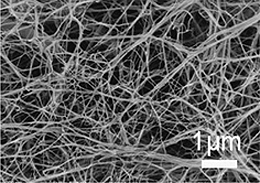バクテリア・セルロースから作られた高導電性高伸縮性導電体
Highly conductive and stretchable conductors fabricated from bacterial cellulose.
2012年6月1日 NPG Asia Materials 4, e6 (2012) doi:10.1038/am.2012.34
フレキシブル・エレクトロニクス:バクテリアの力を借りる

このたび、中国科学技術大学(安徽省)のShu-Hong Yuをはじめとする研究チームが、簡便で費用効果の高いフレキシブル導電体作製法を考案した。近年、曲げたり引き伸ばしたりできる導電材料の必要性が高まってきているが、こうした特性は従来の導電体では実現が困難であった。そんな中、研究チームは今回、バクテリア・セルロースを用いることでこの問題を解決した。セルロースは主に植物の成分として知られているが、簡便で大量生産可能な微生物発酵によって高純度で生産できる。バクテリア・セルロース膜を凍結乾燥後、熱分解処理することで、絡み合ったナノファイバーからなる丈夫なエアロゲルが得られ、このエアロゲルをポリマーに含浸させるとコンポジット材料が得られる。この材料は、優れた電気伝導性を示すだけでなく、引き伸ばしたり曲げたりしても特性が維持されることから、折り曲げ可能なフレキシブル電子機器用に非常に好適だといえる。
Flexible electronics: Bacteria chip in
Shu-Hong Yu and co-workers at the University of Science and Technology of China in Hefei have devised an easy and cost-effective approach to prepare flexible conductors. Increasingly, conducting materials are required to be stretchable and bendable - properties that are difficult to achieve with conventional conductors. Yu and colleagues have now turned to bacterial cellulose to get around this problem. Although cellulose is mostly known as a component of plants, it can be generated, in high purity, by some micro-organisms through fermentation - a facile process that can be carried out in large quantities. Bacterial cellulose pellicles were treated by freeze-drying and pyrolysis to give a robust aerogel composed of entangled nanofibres, which was then infiltrated with a polymer. The resulting composite material showed excellent electrical conductivity, which was maintained even under stretching and bending, and is thus very well suited to applications in flexible, foldable electronics.

